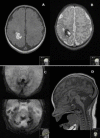Severe intracranial haemorrhage in neonatal alloimmune thrombocytopenia
- PMID: 22679192
- PMCID: PMC3176384
- DOI: 10.1136/bcr.07.2011.4563
Severe intracranial haemorrhage in neonatal alloimmune thrombocytopenia
Abstract
Neonatal alloimmune thrombocytopenia is a rare (1/1000-5000 births) life-threatening disorder, caused by fetomaternal incompatibility for a fetal human platelet alloantigen inherited from the father, with production of maternal alloantibodies against fetal platelets, leading to severe thrombocytopenia and potential bleeding. Intracranial haemorrhage is the most feared complication. This report presents the case of a term newborn infant, born from caesarean section after a normal pregnancy, presenting signs of skin bleeding with different ages. Obstetric history included a previous spontaneous abortion after amniocentesis. Severe thrombocytopenia (4×10(9)/l platelets) was found and brain ultrasound showed multiple intracranial haemorrhages. Human platelet antigen (HPA) phenotyping showed maternal negative HPA-1a and paternal positive HPA-1a platelets. Strongly positive anti-HPA-1a and weakly positive anti-human leukocyte antigen class I alloantibodies were found in the mother. Multiple platelet transfusions, intravenous immunoglobulin and corticosteroid were given but favourable response was accomplished only after a compatible platelet transfusion. Brain MRI showed multiple subacute and chronic haemorrhages.
Conflict of interest statement
Figures




Similar articles
-
A rare manifestation of neonatal alloimmune thrombocytopaenia.BMJ Case Rep. 2014 Jun 2;2014:bcr2014204393. doi: 10.1136/bcr-2014-204393. BMJ Case Rep. 2014. PMID: 24891486 Free PMC article.
-
[Foetal/neonatal alloimmune thrombocytopenia. A review and case report].An Sist Sanit Navar. 2008 Sep-Dec;31(3):281-7. doi: 10.4321/s1137-66272008000500007. An Sist Sanit Navar. 2008. PMID: 19165293 Review. Spanish.
-
A review of the contemporary management of fetal and neonatal alloimmune thrombocytopenia in an Australian tertiary obstetric hospital.Aust N Z J Obstet Gynaecol. 2012 Aug;52(4):321-6. doi: 10.1111/j.1479-828X.2012.01438.x. Epub 2012 Apr 17. Aust N Z J Obstet Gynaecol. 2012. PMID: 22510050 Review.
-
Fetal and neonatal alloimmune thrombocytopenia.Best Pract Res Clin Obstet Gynaecol. 2008 Feb;22(1):3-14. doi: 10.1016/j.bpobgyn.2007.08.001. Epub 2007 Oct 23. Best Pract Res Clin Obstet Gynaecol. 2008. PMID: 17936686 Review.
-
Postnatal treatment for children with fetal and neonatal alloimmune thrombocytopenia: a multicentre, retrospective, cohort study.Lancet Haematol. 2022 Nov;9(11):e844-e853. doi: 10.1016/S2352-3026(22)00243-5. Epub 2022 Sep 12. Lancet Haematol. 2022. PMID: 36108655
Cited by
-
Maternal anti-platelet β3 integrins impair angiogenesis and cause intracranial hemorrhage.J Clin Invest. 2015 Apr;125(4):1545-56. doi: 10.1172/JCI77820. Epub 2015 Mar 16. J Clin Invest. 2015. PMID: 25774504 Free PMC article.
-
Platelets and platelet alloantigens: Lessons from human patients and animal models of fetal and neonatal alloimmune thrombocytopenia.Genes Dis. 2015 Jun 1;2(2):173-185. doi: 10.1016/j.gendis.2015.02.003. Genes Dis. 2015. PMID: 28345015 Free PMC article.
-
A rare manifestation of neonatal alloimmune thrombocytopaenia.BMJ Case Rep. 2014 Jun 2;2014:bcr2014204393. doi: 10.1136/bcr-2014-204393. BMJ Case Rep. 2014. PMID: 24891486 Free PMC article.
References
-
- Fernandes CJ. Neonatal Thrombocytopenia. http://www.uptodate.com/contents/neonatal-thrombocytopenia (accessed 15 Feb 2011).
-
- Blanchsette VS, Johnson J, Rand M. The management of alloimmune neonatal thrombocytopenia. Baillieres Best Pract Res Clin Haematol 2000;13:365–90 - PubMed
-
- Berkowitz RL, Bussel JB, McFarland JG. Alloimmune thrombocytopenia: state of the art 2006. Am J Obstet Gynecol 2006;195:907–13 - PubMed
-
- Arnold DM, Smith JW, Kelton JG. Diagnosis and management of neonatal alloimmune thrombocytopenia. Transfus Med Rev 2008;22:255–67 - PubMed
-
- Mendes LR, Ferrão A, Malcata C, et al. trombocitopénia neonatal aloimune –apresentação clínica tardia. Acta Pediatr Port 2006;7:27–9
Publication types
MeSH terms
Substances
LinkOut - more resources
Full Text Sources
